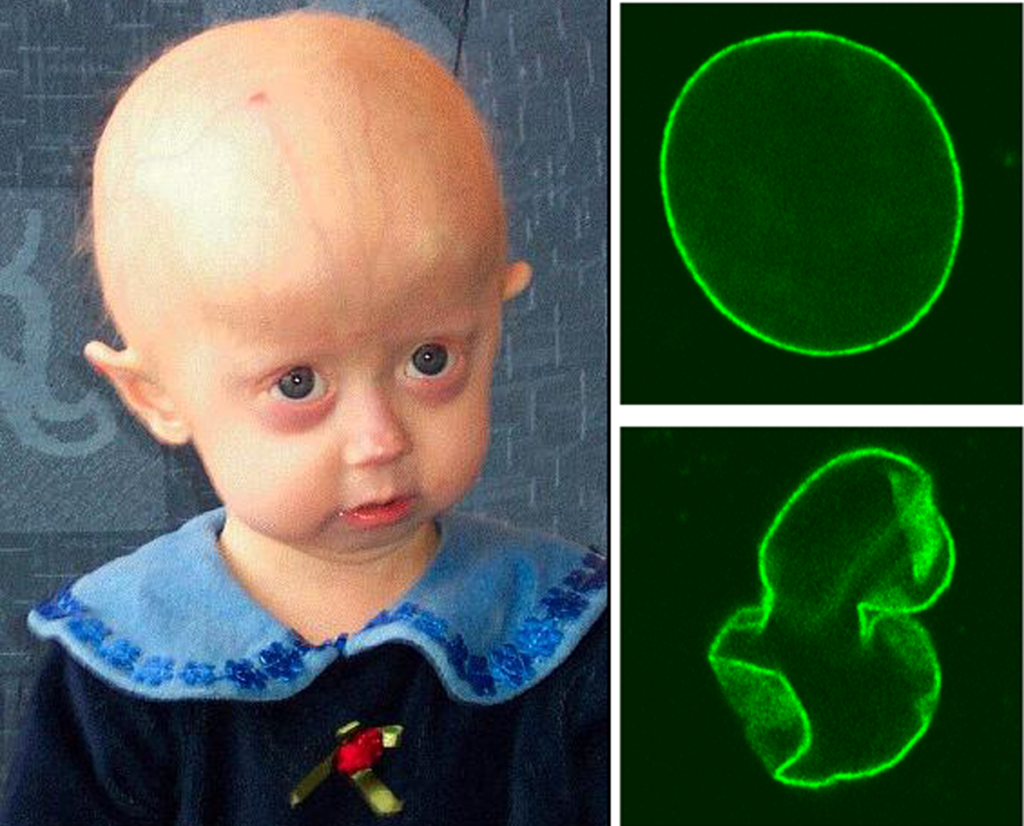Progeria:

What is Progeria?
Progeria, formally known as Hutchinson-Gilford Progeria Syndrome (HGPS), is an exceptionally rare genetic disorder characterized by rapid aging in children.
Causes of Progeria
Progeria is caused by a mutation in the LMNA gene, resulting in the production of an abnormal protein called progerin. This protein disrupts normal cell function, leading to the characteristic features of the condition.
1. Genetic Mutation in the LMNA Gene
The primary cause of progeria is a genetic mutation in the LMNA gene. This gene provides instructions for making a protein called lamin A, essential for maintaining the structure and function of the cell nucleus. The mutation in the LMNA gene leads to the production of an abnormal protein called progerin. Progerin disrupts normal cell function, contributing to the characteristic features of progeria.
2. Spontaneous Mutation
In most cases, the mutation responsible for progeria occurs spontaneously and is not inherited from parents. This means affected individuals typically have no family history of the condition. The mutation arises during early fetal development or shortly after conception.
3. Genetic Inheritance
While rare, progeria can be inherited from one or both parents in some cases. This occurs when the mutation in the LMNA gene is passed down through generations in an autosomal dominant pattern. However, inherited forms of progeria are extremely uncommon, accounting for only a small percentage of cases.
4. Somatic Mosaicism
Somatic mosaicism is another possible cause of progeria. In this scenario, the mutation occurs randomly in some cells but not others. This can lead to variations in the severity and progression of the condition among affected individuals.
Symptoms of Progeria
1. Physical Features
- Slowed Growth: Children with progeria often exhibit slow growth rates compared to their peers of the same age.
- Hair Loss: Thinning or loss of hair, including scalp hair and eyebrows, is common in individuals with progeria.
- Thin Skin: The skin of affected individuals may appear thin, fragile, and prone to bruising.
- Joint Stiffness: Progeria can cause stiffness and limited range of motion in the joints, making movement difficult.
2. Facial Features
- Small Chin: Individuals with progeria may have a small or underdeveloped chin, contributing to facial asymmetry.
- Prominent Eyes: Bulging or prominent eyes are a common characteristic of progeria.
- Disproportionate Head: A disproportionately large head relative to the body size is often observed in individuals with progeria.
3. Cardiovascular Issues
- Atherosclerosis: Progeria increases the risk of developing atherosclerosis, a condition characterized by the hardening and narrowing of the arteries.
- Cardiovascular Disease: Individuals with progeria are at higher risk of developing cardiovascular complications, such as heart attacks and strokes, at a young age.
4. Other Symptoms
- Dental Issues: Dental abnormalities, including delayed tooth eruption and overcrowding, may occur in individuals with progeria.
- Hearing Loss: Some individuals with progeria may experience hearing loss or other ear-related problems.
- Fatigue: Fatigue and weakness are common symptoms reported by individuals with progeria, impacting their overall energy levels and stamina.
Treatment
While there is no cure for progeria, treatment focuses on managing symptoms and improving quality of life. This may involve medications to address cardiovascular issues, physical therapy to enhance mobility, and nutritional support to ensure adequate growth and development.
Lifestyle in Progeria
Living with progeria presents unique challenges, but with proper support and care, affected individuals can lead fulfilling lives. Regular medical check-ups, a balanced diet, and physical activity are essential components of managing the condition.
Prognosis:
The prognosis for individuals with progeria varies, but sadly, the condition typically leads to a shortened lifespan. Most individuals with progeria succumb to complications of heart disease, usually in their teens or early twenties.
History:
Progeria was first described by Dr. Jonathan Hutchinson in 1886 and later by Dr. Hastings Gilford in 1897. Since then, research into the condition has advanced significantly, leading to a better understanding of its causes and potential treatments.
In conclusion, while progeria remains a challenging condition without a cure, ongoing research offers hope for improved treatments and outcomes in the future. By raising awareness and supporting affected individuals and their families, we can strive towards a better understanding and management of this rare genetic disorder.


Pingback: Common health conditions - MedWebMD